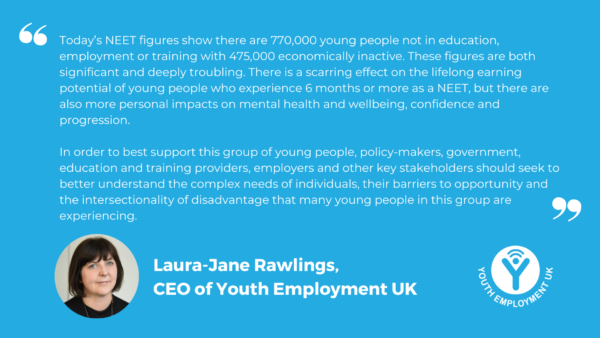Today the Office for National Statistics released the quarterly data set on young people not in education, employment or training (NEET). These figures cover the months from January – March 2023.
The Headlines
- 770,000 young people were NEET, a decrease of 18,000 on the previous quarter.
- The percentage of all young people who are NEET is estimated at 11.3%, this has decreased on the previous quarter by 0.2ppts, however the NEET rate is higher than the pre-pandemic rate of 11.06% (October-December 2019)
- From January – March 2023, there were an estimated 295,000 unemployed young people who were NEET, down by 3,000 on the previous quarter.
- There were an estimated 475,000 economically inactive young people who were NEET, a decrease of 15,000 on the last quarter.
- The decrease in the overall NEET level was also entirely driven by men, with 26,000 fewer men aged 16-24 being NEET when compared to the previous quarter.
- The number of young women aged 16-24 who are NEET grew by 9,000 in the previous quarter.
CEO, Laura-Jane Rawlings, Comment:
“The data released today reveals there are 770,000 young people not in education, employment or training. Concerningly, 475,000 (62%) of this group are economically inactive which means that they are not currently looking for employment or accessing employment support programmes.
These numbers are both significant and deeply troubling. There is a scarring effect on the lifelong earning potential of young people who experience 6 months or more as a NEET, but there are also more personal impacts on mental health and wellbeing, confidence and progression.
In order to best support NEET young people, policy-makers, government, education and training providers, employers and other key stakeholders should seek to better understand the complex needs of individuals, their barriers to opportunity and the intersectionality of disadvantage that many young people in this group are experiencing.
There is no one-size-fits all solution to such a complex and nuanced picture, however, we must start first by listening to young people, their experiences, challenges and the support they need.”
NEET Data By Age
49,000 16-17-year-olds are NEET:
- The number of 16-17 who are NEET has decreased by just over 10,000 on the last quarter
- 3.3% of 16-17-year-olds are NEET. This is down by 0.7 ppts on the last quarter
- 15,500 are unemployed
- 34,000 are economically inactive
722,000 18-24-year-olds are NEET:
- 13.44% of 18-24-year-olds are NEET
- 280,000 are unemployed
- 441,500 are economically inactive
NEET Data By Sex
Males:
- 389,000 of all 16-24-year-old men are NEET
- 181,000 are unemployed
- 208,000 are economically inactive
- 11.1% of 16-24-year-old males are NEET
Females:
- 381,000 of all 16-24-year-old women are NEET
- 114,00 are unemployed
- 267,000 are economically inactive
- 11.4% of 16-24-year-old women are NEET
Key Definitions
The Office for National Statistics provides the following definitions for the key terms used in this data set.
NEET
Anybody who is not in any of the forms of education or training as listed below and not in employment is considered to be NEET. As a result, a person identified as NEET will always be either unemployed or economically inactive.
Education and training
People are considered to be in education or training if they:
- are enrolled on an education course and are still attending or waiting for term to start or restart
- are doing an apprenticeship
- are on a government-supported employment or training programme
- are working or studying towards a qualification
- have had job-related training or education in the last four weeks
Economic inactivity
People not in the labour force (also known as economically inactive) are not in employment, but do not meet the internationally accepted definition of unemployment because they have not been seeking work within the last four weeks and/or they are unable to start work in the next two weeks.
Employment
Employment measures the number of people in paid work, or those who had a job that they were temporarily away from (for example, because they were on holiday or off sick). This differs from the number of jobs because some people have more than one job.
Unemployment
Unemployment measures people without a job who have been actively seeking work within the last four weeks and are available to start work within the next two weeks.












